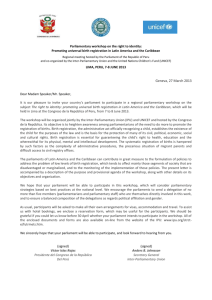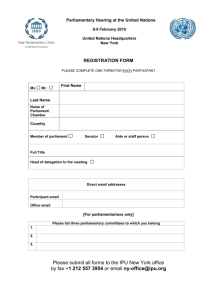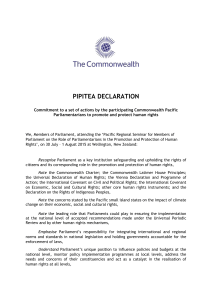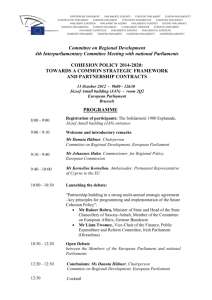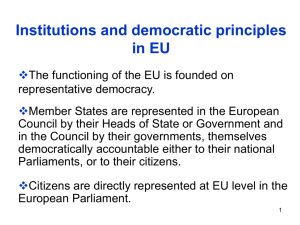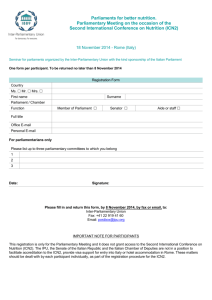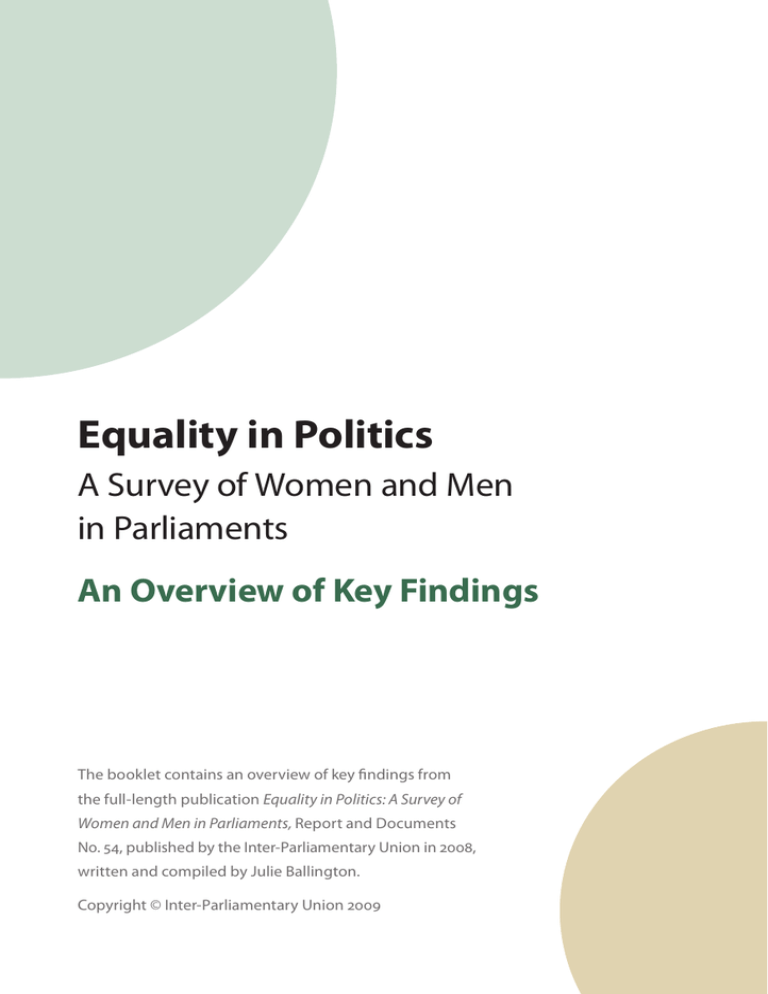
Equality in Politics
A Survey of Women and Men
in Parliaments
An Overview of Key Findings
The booklet contains an overview of key findings from
the full-length publication Equality in Politics: A Survey of
Women and Men in Parliaments, Report and Documents
N0. 54, published by the Inter-Parliamentary Union in 2008,
written and compiled by Julie Ballington.
Copyright © Inter-Parliamentary Union 2009
Equality in Politics
A Survey of Women and Men in Parliaments
Overview of the Report
Parliament is the place For the past decade, the IPU has based its work on the
where a country’s policy principle that there is a fundamental link between democdirection is set. A demo- racy and a genuine partnership between men and women
cratic parliament reflects in the management of public affairs. One of our core aims
the views and interests is to improve women’s access to, and participation in, parof the society from which liament and to build real political partnerships between
it is drawn and allows men and women. Our efforts are informed by the collecthose perspectives to tion and analysis of data on the subject. This report is our
shape the society’s social, most recent contribution to the ongoing discussion about
political and economic how to achieve full partnership between men and women
future. When women are in parliament. The report collates the views and experiinvolved in all aspects of ences of parliamentarians from all regions of the world
political life, including that has been gathered through survey research.
as members of parliament,
societies are more equitable and democracy is both strengthened and enhanced.
Although the number of women in parliaments around the world has been
increasing steadily over recent years, women still occupy a disproportionately
smaller percentage of parliamentary seats than do men. Fewer than one out of
five parliamentarians are women.
The Inter-Parliamentary Union’s (IPU) Equality in Politics: A Survey of Women
and Men in Parliaments presents insights from both men and women in parliament into what shapes decision-making. This Report highlights the factors that
2
Inter-Parliamentary Union Reports and Documents No. 54
influence entry into politics, assesses how the political priorities of women and
men differ and identifies the ways in which women are making their presence
felt in parliament. The Report also addresses the different mechanisms that may
be employed to promote gender-sensitive parliamentary institutions.
The survey, conducted between 2006 and 2008, finds that prejudice and
cultural perceptions about the role of women, together with a lack of financial
resources, are among the greatest obstacles to women’s entry into politics. Yet
once they do become involved, women bring different views, talents and perspectives to politics. While not a homogenous group, women’s shared experiences
affect how they prioritize issues politically. Women parliamentarians are the most
ardent supporters of women and have been responsible for putting women’s concerns and issues on the parliamentary agenda.
The survey also finds that women’s progress in parliament has been patchy,
with most parliamentarians agreeing that gender equality is only “occasionally”
or “rarely” mainstreamed in parliament. Few political parties actively promote
a gender-equality agenda, and few women hold the top decision-making positions in parties. While some parliaments and political parties have implemented
reforms to make them more gender-sensitive, in many ways, the study attests to
the fact that gender equality in parliaments remains an ideal, not yet a reality.
Equality in Politics An Overview of Key Findings
3
many committee assignments and thus end up burdened with heavier workloads than their male counterparts.
1. Executive Summary
An Overview of Key Findings
This study, Equality in Politics: A Survey of Women and Men in Parliaments, aimed
to elicit concrete examples of how parliamentarians are working to attain gender
equality in politics at the national level. During the two years of the research,
the IPU received responses and conducted interviews with nearly 300 parliamentarians in 110 countries in every region of the world. Significantly, 40 percent of
the respondents to this survey were men, making this a unique report.
Among the main findings:
Partnership is the key to real change. Women cannot do it alone. As men
hold the majority of decision-making positions they are central to achieving
change. Women and men must work together to promote gender equality
within political parties, within the institution of parliament, and as part of the
policy-making process.
Political parties matter. They are fundamental in supporting the candidacies of women, and provide a central link between the institutions of governance
and civil society. Political parties set policy priorities and can be key drivers
for positive change.
Parliaments are not gender-sensitive institutions. More than half the
respondents believe that gender equality is only “occasionally” or “rarely” mainstreamed in parliament. While there have been sporadic attempts to modernize
some parliaments, by and large much more needs to be done to improve the
gender sensitivity of parliaments by changing cultural mores and modernizing
operational arrangements.
Women face great obstacles entering politics. Overall, respondents believe
that prejudice and cultural perceptions about the role of women, together
with a lack of financial resources, frequently hinder women’s access to political
life. Most women respondents cite domestic responsibilities as the single most
important deterrent to entering a life in politics, an obstacle rated much lower
among male respondents.
More than 90 percent of all respondents agree that women bring different
views, talents and perspectives to politics. Women parliamentarians are at
the forefront of efforts to combat gender-based violence, and have been instrumental in ensuring that issues such as parental leave and childcare, pensions,
gender-equality laws and electoral reforms that enhance women’s access to
parliaments appear on the legislative agenda.
Numbers do matter. When there are few women in parliament, their lobbying strength and their availability to participate in committee work is limited.
Women parliamentarians often spread themselves too thin by taking on too
4
Inter-Parliamentary Union Reports and Documents No. 54
Equality in Politics An Overview of Key Findings
5
Influence of the different factors that deter men and women from entering politics
Deterrents for women
Aggregate
score
Deterrents for men
Aggregate
score
Domestic responsibilities
3.4
Lack of support from the
electorate
2.9
Prevailing cultural attitudes
regarding the roles of women
in society
3.3
Lack of finances
2.7
Lack of support from family
3.2
Lack of support of political parties
2.7
Lack of confidence
3.2
Lack of experience in “representative functions”: public speaking,
constituency relations
2.7
Chapter 2 provides an over-
Lack of finances
3.1
Lack of confidence
2.6
view of the participation of
Lack of support of political parties
3.1
Lack of education
2.5
2. The Road to Parliament
Less Travelled by Women
Women comprise more than 50 percent of the pool of
those eligible to stand for election and hold political
office in most countries, but that proportion is not
reflected in the composition of decision-making bodies. While the percentage of women in parliament has
grown in recent years, the pace of improvement has
been slow; parity between men and women in parliament remains a long way off.
While both men and women confront obstacles
to entering politics, the particular deterrents differ
in great degree between men and women:
Male survey respondents identify lack of support
from the electorate as the single most important
deterrent, followed by a lack of financial resources.
For women, domestic responsibilities top the list as
the greatest obstacle to a life in politics, followed
closely by prevailing cultural attitudes regarding
the role of women in society.
women and men in parlia-
The score indicates the aggregate level of influence that respondents attached to each of the factors on a four-point scale,
ments around the world. It
where a great deal was scored as 4 and none as 1.
examines the factors that
motivate women and men
to enter parliament, and
that deter them from doing
so, and highlights the challenges that parliamentarians
face in being elected. It also
identifies some of the
mechanisms that are being
introduced to promote more
equal representation of
women and men in politics.
Respondents offer several suggestions for facilitating women’s access to parliament. Implementing electoral quotas for women is considered to be the most
effective way of increasing the number of women candidates. Quotas can and
should be supplemented with other measures, respondents suggest, including
sensitization, education and public awareness-raising programmes, and funding
mechanisms that specifically target women’s candidacies.
Since political parties maintain firm control over the selection of candidates
to contest elections, some respondents recommend working with political parties
to encourage them to promote women’s participation in politics, such as by adopting voluntary party quotas or by placing women in winnable positions on party
lists. Others note that political parties should recruit more women into their
ranks and support their candidatures, including by providing financial support.
Training women candidates in campaigning and communication techniques is
also seen as highly valuable.
Not surprisingly, male respondents cite prevailing
cultural attitudes as one of the least important factors affecting their participation in politics.
6
Inter-Parliamentary Union Reports and Documents No. 54
Equality in Politics An Overview of Key Findings
7
Women bring different views, perspectives and talents to politics
72%
Strongly agree
30%
25%
Agree
3. Women and Men in Parliament
Competing Concerns or
Complementary Agendas?
53%
Neither agree
nor disagree
2%
12%
1%
Disagree
5%
0%
0%
Strongly disagree
0
Some 90 percent of respondents to the survey agree
that women bring different views, talents and perspectives to politics. While by no means a homogenous
group, women tend to highlight women’s concerns.
The concerns that women tend to prioritize include:
Social issues: childcare, equal pay, parental leave
and pensions
interests, perspectives and
priorities of women and
men in parliament. It reports
on parliamentarians’ perceptions about whether
women bring different
perspectives, values and
Physical concerns: reproductive rights, physical
safety and gender-based violence
styles, and if indeed they
Development concerns: human development, poverty alleviation and service delivery
agenda. It also explores,
When asked whether women parliamentarians
have a responsibility to represent the interests of
women in society, 85 percent of women respondents
and 60 percent of male respondents agree. Half of
the women surveyed do not believe that men in parliament can sufficiently represent the interests of
women, while just 43 percent of male respondents
say they can. Although women are predominantly
8
Chapter 3 examines the
Inter-Parliamentary Union Reports and Documents No. 54
are shaping a new political
Female
10
20
30
40
50
60
Male
70
80
responsible for highlighting women’s concerns, several of the women surveyed
emphasize the need to move beyond what is perceived to be a women’s agenda
and to contribute to a broad range of political discussions.
Respondents also acknowledge the difference in style, as well as substance,
that women bring to parliament. The survey asked whether the presence of
women in parliament had resulted in changes in behaviour in the institution.
More than two-thirds of respondents believe that there has been some change:
for example, parliamentary language and behaviour has become less aggressive
since women entered parliament in greater numbers.
for the first time comprehensively, men’s views on
these issues, and whether
men and women are allies in
shaping a gender-equality
agenda.
Equality in Politics An Overview of Key Findings
9
Level of activity in different policy areas
4. Policy Development
Women Making their Presence Felt
Men and women parliamentarians who participated
in the survey identify themselves as engaged in different policy areas.
Men claim to be most active in foreign affairs,
economic and trade issues, education and constitutional affairs, while they report low levels of
activity in gender equality, labour and women’s
issues.
Among women, the reverse is true: nearly half of
all women respondents note that they are very
active on women’s issues and gender-equality matters, but less active in economic and trade matters,
finance and defence.
When asked what effect the presence of women
has had on drafting and passing legislation in specific policy areas, both men and women agree that
women parliamentarians have the greatest influence
on legislation related to domestic violence, childcare
and parental leave.
But what level of representation is required for
women to make a difference in shaping policy? The
critical mass theory suggests that women are substan10
Inter-Parliamentary Union Reports and Documents No. 54
Among women respondents
Level
Among male respondents
Level
Women's issues
4.5
Foreign affairs
4.0
Gender equality matters
4.4
Economic and trade matters
3.9
Social and community matters
4.2
Education
3.7
Family-related matters
4.1
Justice and constitutional matters
3.7
Education
4.1
Social and community matters
3.6
Health care
3.9
Infrastructure and development
3.6
Foreign affairs
3.7
Public administration
3.6
The totals indicate the average level of activity that respondents attached to each of the policy areas on a five-point scale,
Chapter 4 examines how
where very active was scored as 5 and not at all as 1.
the different perspectives
and views that women
bring to politics have translated into policy initiatives
by women and men in parliament. It identifies some
of the specific policy areas
that parliamentarians have
focused on and highlights
examples of how women
and men are working together for gender equality.
It addresses some of the
obstacles that women may
come up against in broadening the political agenda,
such as the role of political
parties and whether the
number of women representatives affects their
ability to make a substantive
difference in policy making.
tively represented when institutions and policies begin to be transformed. That is,
the more women representatives there are, the greater the chances that the female
perspective will be presented and considered. Over half of respondents “strongly
agree” and one-third “agree” with the statement that the more women there are
in parliament, the greater the influence they will have on political priorities and
policy. Since women have different life experiences and prioritize issues differently,
an increase in the number of women in parliament would provide a broader
spectrum of views, not just on women’s issues, but on all policy matters.
Numbers do matter. Much of the detailed policy work is done in parliamentary committees. Respondents from countries with low representation of women
in parliament complain that there are just not enough women to participate
effectively in committee work. Women are either left out of policy discussions
or they are overloaded with committee work and stretch themselves too thin to
dedicate sufficient time to that work. The best solution is to increase the number
of women in parliament to ensure that a gender perspective is incorporated into
all policies.
In addition, a stronger partnership between women and men in parliaments
needs to be created. As men form the majority of parliamentarians and dominate
leadership positions, they are important strategic partners for change. Respondents also identified political party support to be the most influential factor in the
adoption of gender-related legislation.
Equality in Politics An Overview of Key Findings
11
Changes in the rules and practices of parliament brought about by the presence of women
9%
Substantial change
6%
22%
Noticeable change
12
Inter-Parliamentary Union Reports and Documents No. 54
34%
Small change
5. Institutional Change
Gender-Sensitive Parliaments
Parliaments are organized and operate according to
established rules, processes and norms that have historically been determined by men. The research finds
that parliaments are not gender sensitive institutions.
More than half the respondents believe that gender
equality is only “occasionally” or “rarely” mainstreamed
in parliament. While there have been sporadic attempts
to modernize some parliaments, by and large much
more needs to be done improve the gender sensitivity of parliaments by changing cultural mores and
modernizing operational arrangements.
For instance, half of the women respondents, and
40 percent of the male respondents, admitted that
they face difficulties in balancing their family and
political commitments. Some parliaments have instituted “family-friendly” reforms, such as changes
in sitting times, in response to the greater number
of women parliamentarians. However, changes to help
both men and women parliamentarians balance
their family responsibilities—such as changes in sitting
times or the provision of on-site childcare—are characterized as modest. Different legislatures approach
the issue with different, usually piecemeal, mechanisms for improvement—if they approach it at all.
18%
43%
30%
No noticeable change
33%
5%
Don’t know
Chapter 5 focuses on the
0%
0
Female
5
10
15
20
25
30
35
Male
40
45
50
institution of parliament.
When women enter parliament, they typically enter
a male domain where the
vast majority function
according to rules established by men. This creates
another set of potential
challenges for women—
challenges that they have
already begun to confront.
This chapter highlights
some of the initiatives that
have been taken and the
changes introduced to
improve the gender sensitivity of parliaments.
Survey respondents identify four factors that can improve gender balance, both
in the institution of parliament, and in the policies parliaments draft and approve:
Political parties are key, particularly the support of the ruling party.
The work of parliamentary committees, particularly in mainstreaming gender, needs to be bolstered, including in, but not limited to, committees that
specialize in gender equality.
The work done by women’s parliamentary caucuses, where they exist, needs
to be enhanced.
Rules and practices that guide the functioning of parliament need to become
more gender sensitive and family-friendly to accommodate the needs of parliamentarians with families.
Reorganization and improvements are needed in all areas of parliamentary
life—both in the evolution of cultural mores so that parliament is more welcoming to men and women from diverse backgrounds, and in the institutions
of parliament, allowing more effective committee work on gender issues, the
emergence of women’s caucuses and more visible roles for women in parliamentary
leadership. Gender equality needs to become one of the measures of institutional
performance. This work must be done by women and men as they develop a
genuine partnership.
Equality in Politics An Overview of Key Findings
13
6. Conclusions
Defining a Future Agenda
Although the number of women in parliament is growing in most regions of the
world, the current level of women’s representation in the world’s parliaments
amounts to a democracy deficit. Increasing the number of women in parliament
is a primary concern; but it is equally important that women, once in parliament,
develop and use their positions of influence to participate substantively in decision
making. While women parliamentarians have proven to be the most ardent
promoters and defenders of women and have redefined political priorities to include
women’s concerns and perspectives, those roles are not exclusively women’s.
Survey respondents identify several priority activities for making parliaments
more sensitive to the needs of both men and women. These include:
Bolstering the capacity of existing committees on gender equality or caucuses
of women parliamentarians;
In many ways, this report attests to the reality that equality in parliaments
remains a long way off. Women parliamentarians continue to face difficulties in
their work—perhaps none greater than seeking change in political structures
developed, and still dominated, by men. In most parliaments, the mainstream is
the “male-stream”—institutions in which networks and clubs that have traditionally excluded women still operate.
It is all too apparent that women who want to act on behalf of women often
face constraints in their work: they lack the support of their parliamentary colleagues or they may find that the gender-based policies they wish to pursue are
at odds with the policies of their political parties.
Political parties are important arenas for policy development and for setting
political priorities, and are therefore one of key institutions through which gender
equality should be promoted. However, far from all political parties that promote gender equality uphold their manifesto pledges in practice, and few women
hold the top decision-making positions within their ranks. This research found
the support of the ruling party to be the most important factor in introducing
and enacting gender-related legislation, making change vital at this level.
The basis of any significant change in women’s access to parliament is political will and a real partnership between men and women. Men and women must
acknowledge and agree that women’s inclusion and equal participation in parliamentary processes not only benefit societies and the global community, but are
also necessary for legitimate democracy. In essence, what parliaments need most
is more women and a new cadre of gender-sensitive men.
Making parliamentary processes and facilities more family-friendly, such as
by providing childcare and revising parliamentary timetables;
Engaging in research, training and networking on gender equality and related
matters, including through international organizations; and
Developing closer relationships with constituents and providing more funding
for support services and outreach work.
Developing parliament-specific indicators or benchmarks for measuring performance in terms of gender mainstreaming would help in designing and evaluating
any and all of the above actions.
14
Inter-Parliamentary Union Reports and Documents No. 54
Equality in Politics An Overview of Key Findings
15
All rights reserved. No part of this publication may be reproduced,
stored in a retrieval system, or transmitted in any form or by any
means, electronic, mechanical, photocopying, recording, or otherwise, without the prior permission of the Inter-Parliamentary
Union. Applications for the right to reproduce or translate this
work or parts thereof are welcomed and should be sent to the
Inter-Parliamentary Union.
Produced with financial support from the Swedish International
Development Agency (Sida)
Inter-Parliamentary Union
5 Chemin du Pommier
CH - 1218 Le Grand-Saconnex/Geneva
Switzerland
Telephone: +41 22 919 41 50
Fax: +41 22 919 41 60
E-mail: postbox@mail.ipu.org
Web site: www.ipu.org
Design and Layout by Rick Jones (rick@studioexile.com)
Printed by SADAG, France

